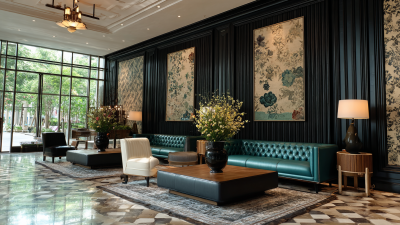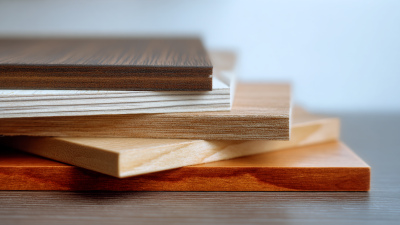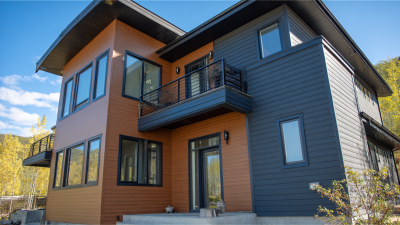How to Choose High Quality Interior Wall WPC Composite Panels for Optimal Durability and Aesthetics
Table of Contents
- Factors to Consider When Selecting WPC Composite Panels for Interior Walls
- Understanding the Properties of WPC Materials for Enhanced Durability
- Comparative Analysis: WPC Panels vs. Traditional Wood and MDF
- The Role of Aesthetic Design in WPC Panel Selection
- Identifying Certified Suppliers for Quality Assurance in WPC Products
- Maintenance Tips to Extend the Lifespan of Interior Wall WPC Panels
- FAQS
- Conclusion
- Related Posts
Lately, there's been a real buzz around using sustainable and good-looking materials for building interiors. People are really into High Quality Interior Wall WPC Composite Panels these days. I was looking at some recent stats, and it turns out the global market for these panels is predicted to hit around USD 9.3 billion by 2025. That's mainly because more folks want lightweight, durable materials for their indoor spaces. Shandong WALLART New Building Material Co., Ltd. is really leading the charge here—they’re combining product innovation, manufacturing, and sales to bring out some pretty cutting-edge WPC and PVC options. What’s cool about WALLART’s panels is not just their durability, but also how they can totally jazz up an interior’s look. They’re a perfect fit for modern designs that want to stand out but stay sustainable. As this industry keeps evolving, knowing what makes these panels stand out—like their quality and look—can really help buyers make smarter choices that match both their style and their need for something long-lasting.

Factors to Consider When Selecting WPC Composite Panels for Interior Walls
So, when you're choosing WPC (Wood Plastic Composite) panels for your indoor walls, there are a few important things to keep in mind to make sure they’re both durable and look good. First off, the composition really matters—top-notch WPC panels usually have about 60-70% wood fibers mixed with 30-40% thermoplastics. Interestingly, a 2022 report from Grand View Research mentioned that the global market for WPC is expected to hit around 9.2 billion USD by 2027. That just goes to show how popular these materials have become, especially since they resist moisture and pests like a champ.
Another thing to watch out for is the thickness and density of the panels. These factors directly impact how long they last and how well they block sound. Industry folks generally recommend at least 10mm thickness for interior use to get the best results. Also, reputable brands usually back up their panels with certifications—that’s their way of showing the panels are resistant to things like fire, fading, and scratches. For example, ratings based on the ASTM E84 standard, which measures how flammable a building material is, can really boost safety in your space. And of course, don’t forget about looks! WPC panels can imitate different types of wood finishes, giving you tons of design options to match whatever style you’re into. A study from the Journal of Building Materials in 2021 even highlighted how versatile these panels are in various interior designs.
Understanding the Properties of WPC Materials for Enhanced Durability
When you're choosing high-quality WPC composite panels for your interior walls, it’s really important to get a good grasp of what WPC materials are all about. Basically, WPC — or wood-plastic composites — mix the best of both worlds: the natural feel of wood and the durability of plastic. They’re great at resisting moisture, rot, and pesky insects, which makes them super handy in spots that tend to get pretty humid. Picking the right mix of materials, like wood fibers along with plastics such as PVC or polypropylene, is key to making sure your panels last and look good over time.
The demand for WPC wall panels is seriously on the rise. Experts expect the market to grow quite a bit, hitting around 6.4 billion dollars by 2025, with an annual growth rate of about 9.2%. This uptick is mainly because people—both homeowners and businesses—are on the lookout for wall coverings that are tough and easy to care for.
Whether you’re going for solid panels or hollow ones, it’s worth thinking about where you’ll put them — like inside your house or on the outside — so they look good and do their job well. By paying attention to the right materials and how the panels will be used, you can pick WPC options that match your style and can stand up to everyday wear and tear without breaking a sweat.
Comparative Analysis: WPC Panels vs. Traditional Wood and MDF
So, when you start comparing WPC (that’s Wood Plastic Composite, by the way) panels to the good old traditional wood and MDF (Medium Density Fiberboard), there’s quite a bit to consider—especially when it comes to durability and looks. WPC panels are basically built to fight off those common issues like moisture seeping in, rotting, and pests, which tend to mess up regular wood. Unlike real wood, WPC doesn’t warp or shrink when the humidity changes—that’s pretty much a lifesaver if you’re dealing with fluctuating indoor conditions. Honestly, this means they last longer and save you some money on maintenance in the long run.

When it comes to looks, WPC panels can mimic natural wood pretty convincingly, plus they give you a more uniform texture and finish. They come in a bunch of colors and styles, so there’s plenty of room for creativity—whether you’re a homeowner or designer. On the flip side, real wood gives off that cozy, authentic vibe but often needs regular staining or sealing to keep looking good. Meanwhile, MDF gives you a smooth surface that's great for painting, but it doesn’t have that natural charm, and it’s more vulnerable to water damage and heavy use. So, if you’re after something that blends durability with good looks, WPC panels really do stand out as a smart choice for modern interiors.
The Role of Aesthetic Design in WPC Panel Selection
When you're picking out WPC (Wood Plastic Composite) panels for your interior walls, the style and design honestly matter a lot—since it really sets the vibe of the whole space. Good-quality WPC panels aren’t just tough and long-lasting; they also do a pretty great job at making your interiors look better. And with more folks leaning toward eco-friendly and stylish materials these days, it’s no surprise that WPC panels are gaining popularity—they give you a nice mix of function and style. Interestingly, recent market trends show that the WPC wall panel industry is expected to jump from about USD 4.5 billion in 2024 to roughly USD 7.2 billion by 2033. That’s a pretty solid growth rate, pointing to how much people want versatile, good-looking options for their interiors.
These panels come in a bunch of finishes, colors, and textures, making them suitable for both modern and traditional decors. When you’re choosing WPC panels, it’s a good idea to think about how well they’ll blend with what's already in your space. Pick wisely, and you can totally change the whole feel of a room—making it look more inviting and stylish. As more options hit the market, both homeowners and designers should really pay attention not just to how durable the panels are, but also to their visual appeal, so your interior looks great for years to come.
How to Choose High Quality Interior Wall WPC Composite Panels for Optimal Durability and Aesthetics - The Role of Aesthetic Design in WPC Panel Selection
| Property | Description | Importance for Aesthetics | Durability Rating (1-5) |
|---|---|---|---|
| Material Composition | Percentage of wood fiber and thermoplastics. | Affects texture and visual appeal. | 4 |
| Surface Finish | Smooth, textured, or printed design. | Influences light reflection and overall finish. | 5 |
| Color Compatibility | Variety of available colors and shades. | Critical for matching with existing decor. | 4 |
| Weight | Density and heft of panels. | Impacts installation and handling. | 3 |
| Moisture Resistance | Ability to withstand humidity. | Prevent mold and decay, essential for durability. | 5 |
Identifying Certified Suppliers for Quality Assurance in WPC Products
When you're on the hunt for high-quality interior wall WPC (Wood Plastic Composite) panels, it's super important to go for certified suppliers. That way, you can be pretty confident about the quality you're getting. I read somewhere—MarketsandMarkets, I believe—that the global WPC market is expected to hit around USD 10.60 billion by 2025. Crazy, right? It really shows just how much demand there’s been for this stuff. But here’s the thing: with the industry booming, it’s a bit tricky to tell which products are legit and which aren’t. The key? Always check if your supplier is certified. Reputable ones follow strict quality standards from organizations like ASTM International, which test things like strength, moisture resistance, and chemical stability—so you know they’re serious about quality.

Also, keep in mind that the performance of WPC panels really impacts how durable and good-looking they’ll be over time. A study by Freedonia Group points out that WPC can actually outperform traditional wood in terms of how long it lasts and how much maintenance they need. So, it’s definitely worth sourcing from suppliers who can show you their certification and test results. Plus, going with a supplier who’s got a solid track record and great customer reviews is just smart — it helps protect your investment and makes sure the panels look good and do their job. And don’t forget to ask for documentation that proves the product’s quality and eco-friendliness. Doing a bit of homework here can save you a lot of headaches down the road.
Maintenance Tips to Extend the Lifespan of Interior Wall WPC Panels
So, when you're picking out high-quality interior wall WPC (Wood Plastic Composite) panels, it’s pretty important to think about both how long they last and how good they look. Shandong WALLART New Building Material Co., Ltd. has a bunch of different WPC options that tick both boxes—making sure your space not only looks awesome but also stays sturdy over time. These panels are actually pretty tough—they resist moisture, bugs, and decay—which makes them a great pick for a bunch of different places.
If you want your WPC panels to stay looking fresh and last longer, regular upkeep is key. A simple trick? Just clean them every now and then with some mild soap and water to get rid of dirt and dust. Try to steer clear of harsh chemicals or anything too abrasive because those can mess up the surface. Also, make sure they’re installed properly with good sealing—that way, you won’t have to worry about moisture sneaking in and causing mold or warping. By doing these little maintenance things, you’ll keep your panels looking great and in good shape for years down the line.
FAQS
: WPC, or wood-plastic composites, combine wood and plastic, providing enhanced resistance to moisture, decay, and insects, making them ideal for high-humidity environments.
The market for WPC wall panels is expected to reach a value of 6400.5 million by 2025 with a compound annual growth rate of 9.2%.
The selection of materials, including wood fibers and plastics like PVC and polypropylene, is crucial for ensuring the longevity and performance of WPC panels.
Identify certified suppliers who adhere to quality standards set by organizations like ASTM International, which evaluate aspects such as strength and moisture resistance.
The growth of the industry creates challenges in differentiating reliable suppliers from subpar products, making it important to do thorough research.
Research shows that WPC materials often outperform traditional wood in longevity and maintenance, making them a more durable choice.
It is essential to consider the application (internal wall cladding or external facades) and ensure the panels meet both aesthetic and functional requirements.
Positive customer feedback can indicate a supplier's reliability and the quality of their products, which safeguards your investment in WPC materials.
Always request documentation that verifies product quality and sustainability to make informed purchasing decisions.
WPC panels are available in both solid and hollow designs, catering to various design visions and functional needs.
Conclusion
Picking out high-quality WPC composite panels for your interior walls is a pretty smart move if you're aiming for durability combined with good looks. There’s quite a bit to keep in mind—first off, the unique features of WPC make it way more durable than your average wood or MDF. Plus, don’t forget about how the design lines up with your overall decor; the visual style really matters when choosing the right panels.
When you're on the hunt for these panels, it’s a good idea to go for trusted suppliers like Shandong WALLART New Building Material Co., Ltd. — they’re specialists in WPC interior products and stand behind their quality. And a little upkeep goes a long way. Regular maintenance can seriously help these panels last longer, making them a smart investment for your space.
Getting a grip on all these points means you, whether you're a homeowner or a builder, can make smarter choices to not only boost the beauty of your interiors but also ensure they stand the test of time with top-notch WPC composite panels.
Related Posts
-

How to Elevate Your Space with Wpc Fluted Wall Design
-

5 Essential Tips to Determine the Best WPC Wall Panel Prices in India
-

How to Choose the Right WPC Wall Panel for Optimal Durability and Aesthetic Appeal
-

Essential Guide to Choosing the Right WPC Wall Siding for Your Project Based on Industry Trends
-

How to Elevate Your Space with PVC Decorative Wall Paneling: A Complete Guide
Blog Tags:

Liam
-

Phone
-

E-mail
-

WhatsApp
Send Us A Message
Get Price And Free Samples Right Now!
